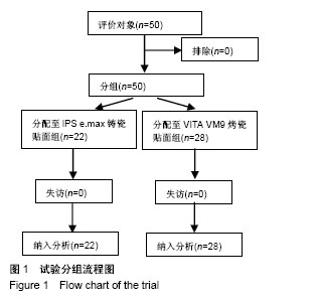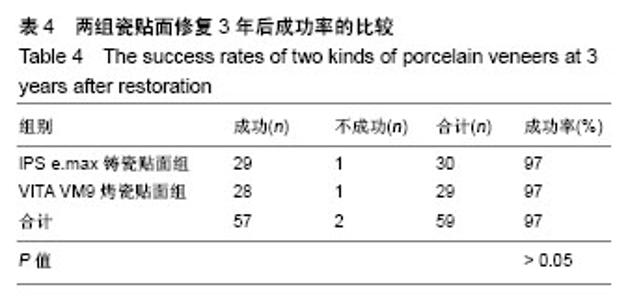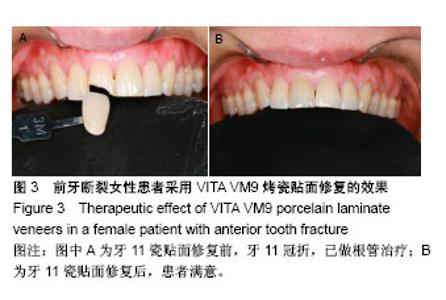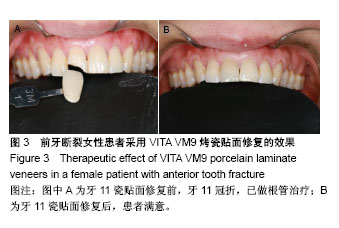| [1] 邹波.梁钦业.严伟浩.部分覆盖瓷贴面在上前牙切角缺损修复的临床应用[J].中华医学美学美容杂志,2009,15(6):399-401.[2] 樊聪,冯海兰.IPS-Empress瓷贴面修复前牙间隙2年的临床评价[J].口腔颌面修复学杂志,2004,5(3):218-221.[3] 洪延青,宓勇,姜涛.Vita Mark II与饰瓷结合强度的比较与分析[J].实用口腔医学杂志,2014,30(2):169-172.[4] 陈明铭,王敏娜,王磊,等.不同比例纳米二氧化钛涂层与可切削硅基陶瓷匹配性的研究[J].临床医药文献杂志, 2015,30(2): 6165-6168.[5] 景璐君,吴获,刘迪,等.氧化锆表面制备衬里层对锆一瓷结合力影响的初步研究[J].口腔颌面修复学杂志,2016,17(2):102-106.[6] 马永刚,先锋,杨 巍.激光表面处理对树脂粘接剂与Y-TZP陶瓷冠粘接强度的影响[J].口腔颌面修复学杂志, 2012,13(3):175-178.[7] Ryge G.Clinical criteria.Int Dent J.1980;30(4):347-358.[8] 李蓉,蒋滔,王贻宁,等.烤瓷贴面与计算机辅助设计与计算机辅助制作瓷贴面的应用效果比较[J].中华口腔医学杂志, 2007,42(6): 330-332.[9] Beier US,Kapferer I,Burtscher D,et al.Clinical perform-ance of porcelain laminate veneers for up to 20 years.Int J Prosthodont. 2012;25(1):79-85.[10] Kreulen CM,Creugers NH,Meijering AC.Meta-analysis of anterior veneer restorations in clinical studies.J Dent. 1998; 26(4):345-353.[11] Dumfahrt H,Schffer H.Porcelain laminate veneers. Aretrospective evaluation after 1 to 10 years of service: PartII-Clinical results.Int J Prosthodont.2000;13(1):9-18.[12] Peumans M,De Munck J,Fieuws S,et al.A prospective ten-year clinical trial of porcelain veneers.J Adhes Dent. 2004;6(1):65-76.[13] Fradeani M,Redemagni M,Corrado M.Porcelain laminate veneers: 6- to 12-year clinical evaluation-a retrospective study.Int J Periodontics Estorative Dent.2005;25(1):9-17.[14] 杜瑞钿,李彦,范丹妮.310个烤瓷贴面远期临床效果的回顾性分析[J].中华口腔医学杂志,2009,44(6): 343-346.[15] Schlichting LH,Resende TH,Reis KR,et al.Simplified treatment of severe dental erosion with ultrathin CAD-CAM composite occlusal veneers and anterior bilaminar veneers.J Prosthet Dent. 2016;116(4):474-482.[16] 刘晶,曾妃菲,李莺,等.二矽酸锂基铸瓷贴面修复氟斑牙的美学效果[J].口腔颌面修复学杂志,2015,16(1):36-40.[17] 樊聪,冯海兰.IPS- Empress铸瓷贴面的临床效果评价[J].现代口腔医学杂志,2006,20(20):139-141.[18] Turgut S,Bagis B,Ayaz EA.Achieving the desired color in discoloured teeth, using leucite-based cad-cam laminate Systems.J Dent.2014;4(2):68-74.[19] Kurklu D,Azer SS,Yilmaz B,et al.Porcelain thickness and cement shade effects on the color and translucency of porcelain veneering materials.J Dent.2013;41(11):1043-1050.[20] Turgut S,Bagis B.Effect of resin cement and ceramic thicknesson final color of laminate veneers: an in vitro study.J Prosthet Dent.2013;109(3):179-186.[21] Xing W,Jiang T,Ma X,et al.Evaluation of the esthetic effect of resin cements and try-in pastes on ceromer veneers.J Dent. 2010;38 (Suppl 2):e87-94.[22] 张大鹏,王书明,郑亚琪,等.西安地区人上颌中切牙牙冠三维结构的研究[J].牙体牙髓牙周病学杂志,2015,25(4):229-233.[23] 孙冠阳,吴国锋,张大鹏,等.人上颌中切牙全瓷贴面牙体预备量的研究[J].牙体牙髓牙周病学杂志,2016,26(7):427-430.[24] Fischer J,Stawarczyk B,Sailer I,et al.Shear bond strength between veneering ceramics and ceria-stabilized zirconia/alumina.J Prosthet Dent.2010;103(5):267-274. [25] Zimmer S,Ghlich O,Rüttermann S,et al.Long-termsurvival of Cerec restorations: a 10-year study. Oper Dent. 2008; 33(5): 484-487.[26] 赵三军,陈明.全瓷贴面临床规范化修复[J].实用口腔医学杂志, 2013,29(1):137-140.[27] 赵铱民,陈吉华.口腔修复学[M].7版.北京:人民卫生出版社, 2013: 121.[28] 杜瑞钿,李彦,范丹妮,等.烤瓷贴面临床效果相关影响因素的回顾性研究[J].口腔颌面修复学杂志,2014,15 (1):15-20.[29] Kwanghyun K,Kyuho L,Ahran P,et al.Esthetic restoration using Digital Smile Design: a case report.J Korean Acad Prosthodont.2015;53(2):144-149.[30] 白杨.医学心理学[M].郑州:郑州大学出版社,2008:92-120. |











